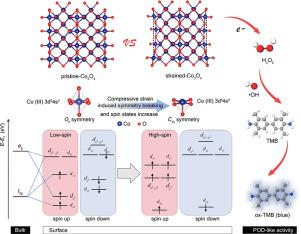Engineering the high-spin 3d orbital in Co3O4 via compressive strain to enhance Immunochromatographic assay
IF 13.2
1区 工程技术
Q1 ENGINEERING, CHEMICAL
引用次数: 0
Abstract
Enhancing catalytic activity of peroxidase-like nanozymes is essential for developing ultrasensitive lateral flow immunoassay (LFIA). The peroxidase-like catalytic process involves spin-dependent electron transfer during radical formation, and boosting single electron transfer (SET) efficiency is therefore critical to enhance catalytic performance. Here, we fabricated a strained-Co3O4 exhibiting significant atomic compressive strain (εxx = −3.34 %, εyy = −6.52 %). The atomic-level displacement direction and distance information determined by atomic displacement analysis (ADA) offer detailed information for density functional theory computational modeling. We discovered that the strain engineering elevated crystal field splitting energy, which promotes the transition of Co3O4 from low-spin states (t2g6eg0) to high-spin states (t2g4eg2), resulting in efficient SET performance. Spin-state modulation dramatically enhances the peroxidase-like catalytic efficiency, resulting in 28.0-fold and 11.8-fold lower Michaelis constants (Km) for TMB and H2O2, respectively, than those of the pristine-Co3O4. In addition, the strained-Co3O4 was successfully employed in the development of LFIA for Xanthomonas oryzae pv. oryzae (Xoo) monitoring, and the LFIA achieved a detection sensitivity of 5 × 102 CFU mL−1 that was 20-fold higher than Au nanoparticles-based LFIA and was 2–3 orders of magnitude higher than commercial LFIAs. Our findings established a correlation between strain–spin orbit–peroxidase-like activity, offering a promising strategy for the rational design of nanozymes.

用压缩应变法设计Co3O4的高自旋三维轨道以增强免疫层析分析
提高过氧化物酶样纳米酶的催化活性是发展超灵敏横向流动免疫分析法(LFIA)的必要条件。类过氧化物酶催化过程涉及自由基形成过程中自旋依赖的电子转移,因此提高单电子转移(SET)效率对提高催化性能至关重要。本文制备了具有显著原子压缩应变的应变型co3o4 (εxx = −3.34 %,εyy = −6.52 %)。原子位移分析(ADA)确定的原子级位移方向和距离信息为密度泛函理论计算建模提供了详细的信息。我们发现应变工程提高了晶体场分裂能量,促进了Co3O4从低自旋态(t2g6eg0)向高自旋态(t2g4eg2)的转变,从而获得了高效的SET性能。自旋态调制显著提高了类过氧化物酶的催化效率,使TMB和H2O2的米切里斯常数(Km)分别比原始co3o4低28.0和11.8倍。此外,该菌株co3o4已成功应用于水稻黄单胞菌pv的LFIA开发。LFIA的检测灵敏度为5 × 102 CFU mL−1,比基于Au纳米颗粒的LFIA高20倍,比商用LFIA高2-3个数量级。我们的发现建立了菌株-自旋轨道-过氧化物酶样活性之间的相关性,为纳米酶的合理设计提供了有希望的策略。
本文章由计算机程序翻译,如有差异,请以英文原文为准。
求助全文
约1分钟内获得全文
求助全文
来源期刊

Chemical Engineering Journal
工程技术-工程:化工
CiteScore
21.70
自引率
9.30%
发文量
6781
审稿时长
2.4 months
期刊介绍:
The Chemical Engineering Journal is an international research journal that invites contributions of original and novel fundamental research. It aims to provide an international platform for presenting original fundamental research, interpretative reviews, and discussions on new developments in chemical engineering. The journal welcomes papers that describe novel theory and its practical application, as well as those that demonstrate the transfer of techniques from other disciplines. It also welcomes reports on carefully conducted experimental work that is soundly interpreted. The main focus of the journal is on original and rigorous research results that have broad significance. The Catalysis section within the Chemical Engineering Journal focuses specifically on Experimental and Theoretical studies in the fields of heterogeneous catalysis, molecular catalysis, and biocatalysis. These studies have industrial impact on various sectors such as chemicals, energy, materials, foods, healthcare, and environmental protection.
 求助内容:
求助内容: 应助结果提醒方式:
应助结果提醒方式:


